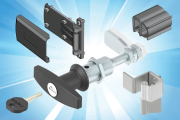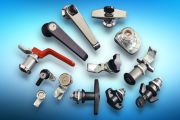 Much has happened in recent years as engineers continue to need ready solutions for their equipment housing. The feedback we receive has driven the development of ubiquitous items like quarter-turn locks and latches which form a core range with companies such as EMKA (UK).
Much has happened in recent years as engineers continue to need ready solutions for their equipment housing. The feedback we receive has driven the development of ubiquitous items like quarter-turn locks and latches which form a core range with companies such as EMKA (UK).
Not so long ago a typical ¼ turn lock was IP54 rated in simple die casting without additional sealing. Firstly flat seals were introduced, then “O” rings, and finally PUR injected seals leading to sealing now commonly available up to IP69.
An early requirement was to look at new materials where leading companies developed capability with reinforced polyamide – for reasons of cost and corrosion resistance as well as stainless steel, which added exceptionally rugged characteristics and corrosion resistance suitable to wash-down areas and marine environments.
As plastics technologies developed greater strength and rigidity were possible so that slim-line polyamide cams could be produced offering cost benefits and reducing paint damage to cabinets.
 Often a simple back nut fixing was the norm but was time consuming where multiple panels were being assembled, so EMKA designed a range of “quick-fit” products which push-in and clip-fix.
Often a simple back nut fixing was the norm but was time consuming where multiple panels were being assembled, so EMKA designed a range of “quick-fit” products which push-in and clip-fix.
The humble ¼ turn latch lock was changing incrementally with customer demand for smooth, cavity-free designs suited to food processing plants and high sealing to withstand regular pressure washing.
At the other end of the scale outdoor environments and rail or other transport vehicles have their needs met with high speed dust cap retention and colour coded open/closed indicators.
Perhaps the biggest change in the world of ¼ turn locks and latches has been the spread of compression function products. These now offer vibration resistance to prevent nuisance door opening, as well as more complete gasket pull-down and consistently higher IP sealings.
 Prior even to 2000 traditional L and T handles were being challenged by relatively new styles of pop-out swinghandles in simple die-cast zinc. These handles offered lower profiles to minimise damage and clothing hazards, while providing convenient, comfortable operation for the user.
Prior even to 2000 traditional L and T handles were being challenged by relatively new styles of pop-out swinghandles in simple die-cast zinc. These handles offered lower profiles to minimise damage and clothing hazards, while providing convenient, comfortable operation for the user.
Parallel developments took place comparable to ¼ turn locks – it is amazing how usage has changed and how products have changed to meet those needs. For similar reasons – enhanced environmental requirements, cost and user friendliness – swinghandles are now produced with “O” rings and PUR seals giving excellent sealing for all applications. Glass reinforced polyamide was introduced as the industry developed slim, strong handle designs alongside stainless steel variants in AISI 304 or 316.
These reinforced machine grade plastics proved extremely capable such that robust anti-vandal designs were possible in these and zinc die – often complimented by low profile escutcheons and inset handles for sealing and anti-tamper purposes.
 “Everything but the Enclosure” technologies have a long lifecycle and there is much from pre 2000 which is still perfectly suitable, but elsewhere we have seen refined engineering capability for standard and custom products including friction welding, sintered metal production and 3D CAD modelling, a process which has not only enabled development of more complex designs, but also put the panel engineer in direct contact with the product designer via detailed downloadable drawings.
“Everything but the Enclosure” technologies have a long lifecycle and there is much from pre 2000 which is still perfectly suitable, but elsewhere we have seen refined engineering capability for standard and custom products including friction welding, sintered metal production and 3D CAD modelling, a process which has not only enabled development of more complex designs, but also put the panel engineer in direct contact with the product designer via detailed downloadable drawings.
Much too has changed in the small things – often overlooked – we can now source pre-cut, pre-assembled and vulcanised gasket, installation-ready without messy cutting and gluing. EMC gaskets have become mainstream, while a major demand has been identified for fire protection and high temperature gaskets in EPDM and silicone.
Previously, assembling rod locks took many minutes, now advances in design and plastics technology mean that rod guides can be fitted in seconds while precision plastic mechanisms provide quiet operation and more comfortable feel than older style units made from die castings or metal stampings. Rod systems not only improved, they moved.
At one time only installed inside the gasket area, rod lock systems migrated beyond the gasket, at the same time freeing up door areas and enabling simpler sealing arrangements for locks etc.
Growth in technology and sophistication of design has been matched with commercial developments which support specialist enclosure and panel builders – toggle latches continue to find new application, torque/friction hinges have become mainstream – not just something to be used on expensive electronic devices, and in response to globalisation we see also an expansion of UL certification.
The future for enclosure hardware shows continued incremental improvements based on the original modular philosophy established to make specialist cabinets better and at lower cost in line with the needs of design, production and installation engineers around the world.
Contact EMKA UK or see our website for further information on our products. All the latest EMKA news can be found on our blog.
